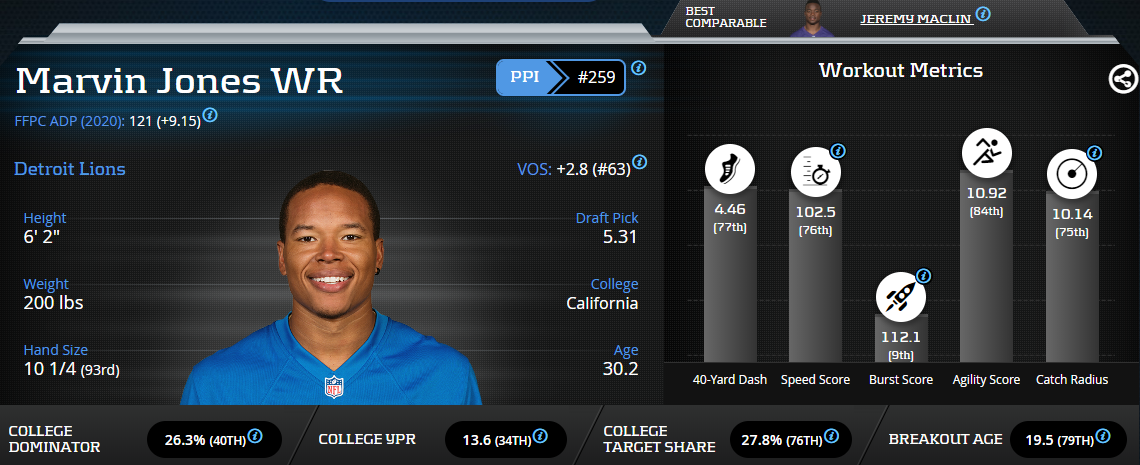Over the last few years, a common fantasy roster construction tactic has been stacking a quarterback and a wide receiver from the same team. The rationale behind this strategy is to increase the team’s volatility, or upside, by leveraging potential fantasy points scored by both the QB and WR on the same plays. This is all the rage in daily fantasy and has also become popular in seasonal formats. Today, we’ll discuss a different kind of stacking that can be implemented in 2020 seasonal fantasy drafts: Team WR Stacks.
Team WR Stacking entails drafting two wide receivers who play for the same NFL team. Traditionally frowned upon, this strategy can be a great way to raise your team’s floor and ceiling when implemented correctly. The main appeal of this tactic is the ability to hedge downside at WR. If we can monopolize the majority of a team’s passing weapons, we can create a situation that leads to a high weekly floor at the position with our team being insulated from injuries and difficult individual matchups. This is especially effective in Best-Ball formats, where stacking gives fantasy gamers all the weekly touchdown exposure and season-long injury protection with no access to a waiver wire.
Why Stack?
Ten teams last year had at least two players who finished as a fantasy WR3 or better. There are opportunities to have multiple fantasy-relevant WRs on the same team. A perfect example last year was Dallas. Amari Cooper and Michael Gallup were available in Round 3 and Round 10, both finishing in the Top-24. Those are season totals, but a common myth is that WRs on the same team are unlikely to be productive in the same week. The thinking goes that if both are started and one booms, the other will likely bust, leaving fantasy teams in trouble. However, from Week 1 through 16 last year, there were six teams that had at least two WR3 performances in seven or more weeks. For such a volatile position, the right team can still see teammates consistently be fantasy relevant on a weekly basis.
Purely hedging downside is not enough though. We want to win our fantasy leagues, not finish in fifth. Team WR Stacking has upside too. Last season, five teams had two or more WRs finish higher than WR24 in Fantasy Points per Game. On a weekly basis, 2019 saw an average of 5.6 teams per week with at least two WR2 finishes or better. The key to Team WR Stacking is to target offenses that will be productive and consolidated. Tampa Bay and Atlanta are both obvious candidates, but their top receivers are too expensive to reliably target both, especially considering our desire to start drafts with bellcow RBs. Let’s turn our attention to potentially cheaper options to target using advanced stats, metrics and FFPC ADP.
Detroit Lions
Kenny Golladay (FFPC ADP: 34.39) has proven himself to be a proper alpha receiver. Babytron led all qualified wide receivers last year with 11 touchdowns and 37 Deep Targets. He put up 1,190 (No. 6) receiving yards with 15.7 (No. 6) yards of Average Target Distance, 18.3 (No. 4) Yards per Reception, and 10.3 (No. 6) Yards per Target. With a third-round price tag, he is pretty expensive, but his running mate Marvin Jones (ADP: 121) can be had much later in drafts.
Despite finishing last year with 14.9 (No. 19) Fantasy Points per Game, Jones’ current ADP puts him at around WR40. After posting a +23.4-percent (No. 15) Target Premium and a +18.4 (No. 14) Production Premium, he is not slowing down with age. The Lions get back a healthy Matthew Stafford on a team that added little of consequence to the passing game. It is wheels up in Detroit for these two to dominate targets again in 2020.
Miami Dolphins
The entire Miami Dolphins team is undervalued at the moment, but no one more so than the receivers. DeVante Parker (ADP: 73.39) and Preston Williams (ADP: 157.57) provide a truly excellent opportunity to Team WR Stack. Parker broke out all over the place last season, finishing as the WR11 after making us wait for years, but do not forget how impressive Williams was before he went down with injury.
Check out Preston William’s 2020 Projection on PlayerProfiler’s “World Famous” Draft Kit:
Williams recorded 14.9 (No. 10) yards of Average Target Distance and a 28.8-percent (No. 21) Dominator Rating before his injury struck. He and Parker again get to play with the ultimate gunslinging QB in Ryan Fitzpatrick, and are likely to start the year on a team that will be frequently losing and forced to continue throwing often. All without significant competition for touches.
Jacksonville Jaguars
D.J. Chark’s (ADP: 63.68) breakout last year was incredibly impressive considering the QBs throwing him the ball. This year, he gets back Gardner Minshew, poised to take another step further in his development from being a late-round rookie thrown into the fire last year. Drafters seem to be a little hesitant, however, with Chark going in the mid-sixth as the WR24 on average.
https://www.youtube.com/watch?v=tzX4Ws-Vbkk&feature=emb_logo
Pairing Chark with Dede Westbrook (ADP: 219.68) provides an inexpensive stack on a team that averaged 39.4 (No. 10) pass plays per game last year, with what should be better QB play and a crumbling defense. They did spend a second round pick on Laviska Shenault, but with a stunted preseason, don’t expect the raw prospect to command many targets early on.
New York Jets
The ultra-budget Team WR Stack is the New York Jets. Jamison Crowder (ADP: 141) may be the cheapest target leader out there. He gobbled up 122 (No. 16) targets last season and has the ability to do so again this year. It may not be pretty given last year’s 8.0 (No. 91) Average Target Distance mark, but the volume is undeniable.
https://www.youtube.com/watch?v=b1YcMvwks9E
In this case, there are two options to pair with Crowder. Two newcomers to the Jets will hope to fill the void left by Robby Anderson’s departure. Breshad Perriman (ADP: 180.93) had several big games as the third receiver on Tampa Bay last year. He fits the Anderson burner role well. There is also rookie second round pick Denzel Mims (ADP: 203.39), who has all the tools to be an alpha receiver in the league. With these ADPs, you can take all three and be confident that you’re soaking up the majority of targets from young gunslinger Sam Darnold.
Conclusion
These Team WR Stacking options presented today give drafters a chance to load up on high floor/high ceiling bellcow backs early in drafts while pairing WRs to produce a solid weekly floor in the middle and late rounds to fill out the roster.



